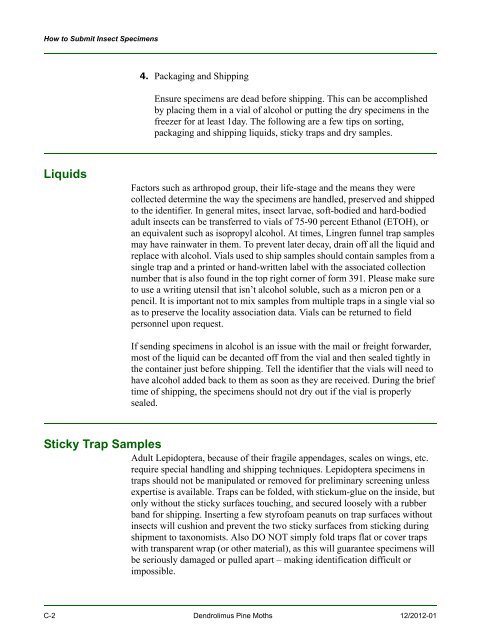New Pest Response Guidelines - aphis - US Department of Agriculture
New Pest Response Guidelines - aphis - US Department of Agriculture
New Pest Response Guidelines - aphis - US Department of Agriculture
You also want an ePaper? Increase the reach of your titles
YUMPU automatically turns print PDFs into web optimized ePapers that Google loves.
How to Submit Insect Specimens<br />
Liquids<br />
4. Packaging and Shipping<br />
Ensure specimens are dead before shipping. This can be accomplished<br />
by placing them in a vial <strong>of</strong> alcohol or putting the dry specimens in the<br />
freezer for at least 1day. The following are a few tips on sorting,<br />
packaging and shipping liquids, sticky traps and dry samples.<br />
Factors such as arthropod group, their life-stage and the means they were<br />
collected determine the way the specimens are handled, preserved and shipped<br />
to the identifier. In general mites, insect larvae, s<strong>of</strong>t-bodied and hard-bodied<br />
adult insects can be transferred to vials <strong>of</strong> 75-90 percent Ethanol (ETOH), or<br />
an equivalent such as isopropyl alcohol. At times, Lingren funnel trap samples<br />
may have rainwater in them. To prevent later decay, drain <strong>of</strong>f all the liquid and<br />
replace with alcohol. Vials used to ship samples should contain samples from a<br />
single trap and a printed or hand-written label with the associated collection<br />
number that is also found in the top right corner <strong>of</strong> form 391. Please make sure<br />
to use a writing utensil that isn’t alcohol soluble, such as a micron pen or a<br />
pencil. It is important not to mix samples from multiple traps in a single vial so<br />
as to preserve the locality association data. Vials can be returned to field<br />
personnel upon request.<br />
If sending specimens in alcohol is an issue with the mail or freight forwarder,<br />
most <strong>of</strong> the liquid can be decanted <strong>of</strong>f from the vial and then sealed tightly in<br />
the container just before shipping. Tell the identifier that the vials will need to<br />
have alcohol added back to them as soon as they are received. During the brief<br />
time <strong>of</strong> shipping, the specimens should not dry out if the vial is properly<br />
sealed.<br />
Sticky Trap Samples<br />
Adult Lepidoptera, because <strong>of</strong> their fragile appendages, scales on wings, etc.<br />
require special handling and shipping techniques. Lepidoptera specimens in<br />
traps should not be manipulated or removed for preliminary screening unless<br />
expertise is available. Traps can be folded, with stickum-glue on the inside, but<br />
only without the sticky surfaces touching, and secured loosely with a rubber<br />
band for shipping. Inserting a few styr<strong>of</strong>oam peanuts on trap surfaces without<br />
insects will cushion and prevent the two sticky surfaces from sticking during<br />
shipment to taxonomists. Also DO NOT simply fold traps flat or cover traps<br />
with transparent wrap (or other material), as this will guarantee specimens will<br />
be seriously damaged or pulled apart – making identification difficult or<br />
impossible.<br />
C-2 Dendrolimus Pine Moths 12/2012-01

















